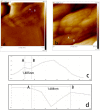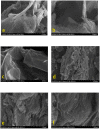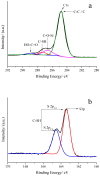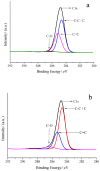Preparation and Properties of SBS-g-GOs-Modified Asphalt Based on a Thiol-ene Click Reaction in a Bituminous Environment
- PMID: 30961189
- PMCID: PMC6401793
- DOI: 10.3390/polym10111264
Preparation and Properties of SBS-g-GOs-Modified Asphalt Based on a Thiol-ene Click Reaction in a Bituminous Environment
Abstract
Styrene-butadiene styrene graphene oxide nanoplatelets (SBS-g-GOs)-modified asphalt was prepared by reacting thiolated GOs (GOs-SH) with SBS in asphalt using a thiol-ene click reaction. The temperature resistance and mechanical properties of asphalts were analyzed by dynamic shear rheology (DSR) and multiple-stress creep-recovery (MSCR) tests, which revealed that an optimum amount of GOs-SH (0.02%) can effectively improve the low temperature and anti-rutting performance of SBS asphalt. Segregation experiments showed that SBS-g-GOs possessed good stability and dispersion in base asphalt. Fluorescence microscopy results revealed that the addition of GOs-SH promoted the formation of SBS network structure. Textural and morphological characterization of GOs-SH and SBS were achieved by Fourier transform infra-red (FT-IR) spectroscopy, energy-dispersive X-ray spectroscopy (EDX), atomic-force microscopy (AFM), X-ray diffraction (XRD), and scanning electron microscopy (SEM), while surface chemical composition was tested by X-ray photoelectron spectroscopy (XPS). Based on textural characterization data, a suitable reaction mechanism was proposed that involved the preferential reaction between GOs-SH and 1,2 C=C of SBS. The currently designed GOs-SH incorporated asphalt via thiol-ene click reaction provides new ideas for the preparation of modified asphalt with enhanced mechanical properties for target-oriented applications.
Keywords: GOs-SH; SBS-g-GOs-modified asphalt; asphalt environment; mechanical properties; textural characterization; thiol-ene click reaction.
Conflict of interest statement
The authors declare no conflict of interest.
Figures






















Similar articles
-
Characterization of Desulfurized Crumb Rubber/Styrene-Butadiene-Styrene Composite Modified Asphalt Based on Rheological Properties.Materials (Basel). 2021 Jul 6;14(14):3780. doi: 10.3390/ma14143780. Materials (Basel). 2021. PMID: 34300699 Free PMC article.
-
Preparation of Octadecyl Amine Grafted over Waste Rubber Powder (ODA-WRP) and Properties of Its Incorporation in SBS-Modified Asphalt.Polymers (Basel). 2019 Apr 11;11(4):665. doi: 10.3390/polym11040665. Polymers (Basel). 2019. PMID: 30979010 Free PMC article.
-
The Properties of Micro Carbon Fiber Composite Modified High-Viscosity Asphalts and Mixtures.Polymers (Basel). 2022 Jul 2;14(13):2718. doi: 10.3390/polym14132718. Polymers (Basel). 2022. PMID: 35808761 Free PMC article.
-
The Modification Mechanism, Evaluation Method, and Construction Technology of Direct-to-Plant SBS Modifiers in Asphalt Mixture: A Review.Polymers (Basel). 2023 Jun 21;15(13):2768. doi: 10.3390/polym15132768. Polymers (Basel). 2023. PMID: 37447414 Free PMC article. Review.
-
A review of the fundamentals of polymer-modified asphalts: Asphalt/polymer interactions and principles of compatibility.Adv Colloid Interface Sci. 2015 Oct;224:72-112. doi: 10.1016/j.cis.2015.07.010. Epub 2015 Aug 1. Adv Colloid Interface Sci. 2015. PMID: 26277208 Review.
Cited by
-
Greener Solution to Waste Corn Stalks and Shortage of Asphalt Resource: Hydrochar Produced by Hydrothermal Carbonization as a Novel Performance Enhancer for Asphalt Binder.Materials (Basel). 2021 Mar 15;14(6):1427. doi: 10.3390/ma14061427. Materials (Basel). 2021. PMID: 33804201 Free PMC article.
-
The Effect of Direct-to-Plant Styrene-Butadiene-Styrene Block Copolymer Components on Bitumen Modification.Polymers (Basel). 2019 Jan 15;11(1):140. doi: 10.3390/polym11010140. Polymers (Basel). 2019. PMID: 30960124 Free PMC article.
-
Properties and Characterization Techniques of Graphene Modified Asphalt Binders.Nanomaterials (Basel). 2023 Mar 6;13(5):955. doi: 10.3390/nano13050955. Nanomaterials (Basel). 2023. PMID: 36903833 Free PMC article. Review.
-
Laboratory Investigation of Lignocellulosic Biomass as Performance Improver for Bituminous Materials.Polymers (Basel). 2019 Jul 29;11(8):1253. doi: 10.3390/polym11081253. Polymers (Basel). 2019. PMID: 31362441 Free PMC article.
-
Effect of Lignin Modifier on Engineering Performance of Bituminous Binder and Mixture.Polymers (Basel). 2021 Mar 29;13(7):1083. doi: 10.3390/polym13071083. Polymers (Basel). 2021. PMID: 33805562 Free PMC article.
References
-
- Wang P., Dong Z.J., Tan Y.Q., Liu Z.Y. Effect of multi-walled carbon nanotubes on the performance of styrene–butadiene–styrene copolymer modified asphalt. Mater. Struct. 2017;50:17. doi: 10.1617/s11527-016-0890-9. - DOI
-
- Chen J., Wang H., Li M., Li L. Evaluation of pavement responses and performance with thermal modified asphalt mixture. Mater. Des. 2016;111:88–97. doi: 10.1016/j.matdes.2016.08.085. - DOI
-
- Baek J., Sang Y.L., Lee H.J. Comparative evaluation of wma additives effects on conventional and polymer modified asphalt pavements. KSCE J. Civ. Eng. 2018;22:2099–2108. doi: 10.1007/s12205-018-1785-9. - DOI
-
- Liang M., Xin X., Fan W., Ren S., Shi J., Luo H. Thermo-stability and aging performance of modified asphalt with crumb rubber activated by microwave and TOR. Mater. Des. 2017;127:84–96. doi: 10.1016/j.matdes.2017.04.060. - DOI
-
- Santagata E., Baglieri O., Dalmazzo D., Tsantilis L. Evaluation of the anti-rutting potential of polymer-modified binders by means of creep-recovery shear tests. Mater. Struct. 2013;46:1673–1682. doi: 10.1617/s11527-012-0006-0. - DOI
Grants and funding
LinkOut - more resources
Full Text Sources
Molecular Biology Databases
Miscellaneous

